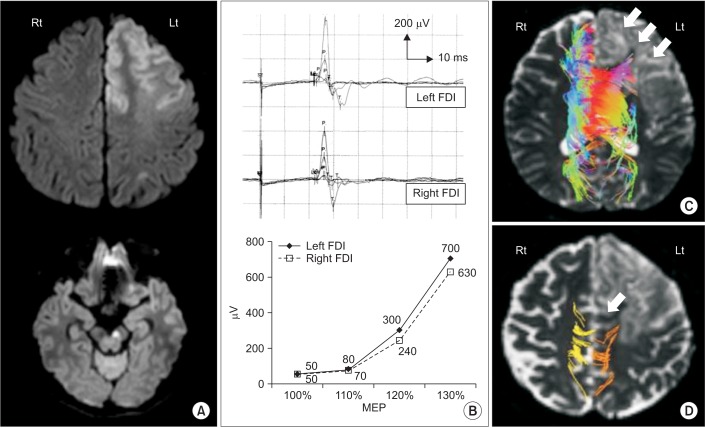Ann Rehabil Med.
2015 Feb;39(1):150-153. 10.5535/arm.2015.39.1.150.
Novel Information on Anatomic Factors Causing Grasp Reflex in Frontal Lobe Infarction: A Case Report
- Affiliations
-
- 1Department of Physical Medicine and Rehabilitation, Hallym University Sacred Heart Hospital, Hallym University College of Medicine, Anyang, Korea. ohnsh@hallym.ac.kr
- KMID: 2273034
- DOI: http://doi.org/10.5535/arm.2015.39.1.150
Abstract
- We report a patient with a severe limitation of function in the right hand resulting from grasp reflex following a stroke affecting the left anterior cerebral artery region. We describe, using diffusion tensor tractography (DTT), a disconnection between the bilateral frontal lobes via the corpus callosum. The patient could not control his right hand at all, even though his bilateral corticospinal tracts were intact. We noted that over the infarcted lesion on DTT, the white matter was invisible from the corpus callosum to the prefrontal cortex. These findings reflected a unique pattern of white-matter disconnection between the ipsilateral medial frontal lobe and ipsilateral and contralateral frontal cortex causing hand function deterioration in the form of severe grasp reflex.
Keyword
MeSH Terms
Figure
Reference
-
1. Ohn SH, Chang WH, Park CH, Kim ST, Lee JI, Pascual-Leone A, et al. Neural correlates of the antinociceptive effects of repetitive transcranial magnetic stimulation on central pain after stroke. Neurorehabil Neural Repair. 2012; 26:344–352. PMID: 21980153.
Article2. Seyffarth H, Denny-Brown D. The grasp reflex and the instinctive grasp reaction. Brain. 1948; 71:109–183. PMID: 18890913.
Article3. Hashimoto R, Tanaka Y. Contribution of the supplementary motor area and anterior cingulate gyrus to pathological grasping phenomena. Eur Neurol. 1998; 40:151–158. PMID: 9748673.
Article4. Mori S, Kaufmann WE, Davatzikos C, Stieltjes B, Amodei L, Fredericksen K, et al. Imaging cortical association tracts in the human brain using diffusion-tensor-based axonal tracking. Magn Reson Med. 2002; 47:215–223. PMID: 11810663.
Article5. Wassermann EM, Epstein CM, Ziemann U. The Oxford handbook of transcranial stimulation. Oxford: Oxford University Press;2008.6. Sumner P, Nachev P, Morris P, Peters AM, Jackson SR, Kennard C, et al. Human medial frontal cortex mediates unconscious inhibition of voluntary action. Neuron. 2007; 54:697–711. PMID: 17553420.
Article7. Heilman KM, Watson RT. The disconnection apraxias. Cortex. 2008; 44:975–982. PMID: 18585696.
Article8. Alexander GE, Crutcher MD. Functional architecture of basal ganglia circuits: neural substrates of parallel processing. Trends Neurosci. 1990; 13:266–271. PMID: 1695401.
Article
- Full Text Links
- Actions
-
Cited
- CITED
-
- Close
- Share
- Similar articles
-
- Changes of Detrusor Function in Patients with Frontal Lobe Lesion
- A Case of Puerperal Cerebral Hemorrhagic Infarction with Venoue Thrombosis
- A Case of Giant Mucocele at Frontal Sinus
- Reflex Epilepsy Provoked by Mental Activities Mainly Associated with Use of the Hands
- Hypersexuality and Obsessive-Compulsive Behaviors in a Stroke Patient with the Left Mesial Frontal Cortex and Both Basal Ganglia Lesion


